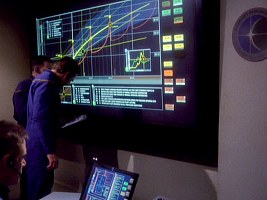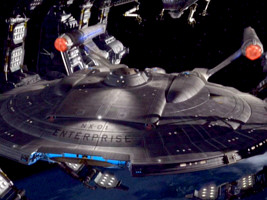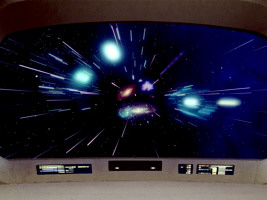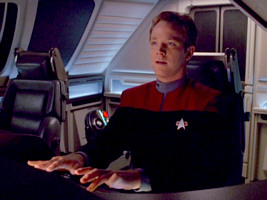6 Warp Speed Measurement
The Physics and Technology of Warp Propulsion
6.1 Concept of Warp Factors6.2 TOS Scale (23rd Century)6.3 TNG Scale (24th Century)6.4 Possible Future Scale
6.1 Concept of Warp Factors
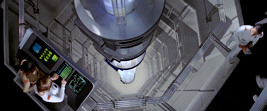
Definition
A warp factor is a unitless figure that represents the speed of a starship or of a signal traveling faster than light. There is a non-linear dependence between the warp factor and the effective FTL speed. In every known variant of the warp scale the speed rises exponentially with the warp factor, meaning that from Warp 1 to Warp 2 the speed more than doubles. The exponent is subject to vary between the scales.
There is no common canon symbol or abbreviation for warp factors, although "WF" or "wf" are sometimes used in textbooks. In spoken language they are referred to as "Warp X" (written with a capital "W") or, now rather antiquated, "warp factor X" during the time of TOS.
In all known warp scales "Warp 1" corresponds to the speed of light. The warp scale is continuous, meaning that real numbers such as "Warp 8.179" are possible, although it seems that starships most often travel at integer warp factors 7, 8, 9, etc.
Warp factors below Warp 1 are occasionally mentioned in Star Trek, mostly in the scope of the 24th century scale. Consequentially these refer to sublight speeds. The question whether something like Warp 0.5 exists has some relevance. Warp 0.5 could either mean that the warp drive also operates at sublight speeds, without a need to activate the impulse engines, or that the warp scale is simply extrapolated below Warp 1, even if only the impulse drive is on. With the note in the TNG Technical Manual [Ste91] that the impulse drive makes use of subspace driver coils the latter makes sense also technically, because if the warp factor generally describes the formation of a subspace field, it may as well apply to the field generated by the driver coils at sublight speed.
Background
Bearing in mind that the speed of light c is already as high as 3*10^8m/s, it is obvious that with conventional units such as meters per second or kilometers per hour as they are used for the speeds of today's planes or spaceships we would end up with unreasonably large and unhandy figures when describing FTL motion. Generally, it may have been possible to switch to something like light years per day or similar manageable time and distance units. The reason why Starfleet introduced the apparently abstract and strangely non-linear warp factor must lie in the physical principle and/or the technical implementation of the propulsion system. In other words, the function of speed vs. warp factor most likely reflects how strong a warp field must be to achieve a certain speed.
Side note Gene Roddenberry may have originally conceived warp factors for the sake of the dramatic impression of Kirk's commands. "Mr. Sulu, ahead Warp factor two." is more precise than "half speed ahead", and it sounds much more to the point than "increase to three light years per day". Moreover, with warp factors obscuring the real speed of the ship, calculation errors between speeds, times and distances mentioned on screen were less likely to occur. It was as late as in TNG that a correlation between all of the three figures was routinely made on screen (most often by Data), revealing the "true" significance of warp factors.
The sawtooth curve of the power expenditure vs. warp factor as shown in Fig. 6.1 and discussed in 3.3 Subspace Fields and Warp Fields is canon since it appeared on screen in ENT: "First Flight". The tips of the sawtooth are the so-called peak transitional thresholds, the points at which the power expenditure rises steeply because there is supposedly a physical threshold (in one possible interpretation, the transition to the next subspace layer) to be crossed. These peak transitional thresholds are located at the integer warp factors 1, 2, 3, and so on. Their existence is evidence that something significant happens at integer warp factors, justifying that the scale is based on these prominent points. In other words, the scale is designed in a way that the warp factors count up certain events that occur as the warp field is being expanded and intensified, which corresponds with an increase in speed.
Fig. 6.1 also shows a reason why ships customarily travel at integer warp factors or slightly above but never slightly below. We have to bear in mind that warp propulsion is non-Newtonian and a constant power supply is required to maintain a constant speed. If we imagine for a moment that the peaks are smoothed out, the power consumption (yellow sawtooth curve) overall increases stronger with the warp factor than the speed v/c (white for the TNG scale) does. In other words, the faster a ship goes, the higher is the energy consumption for the trip.
However, as we take into account the peak transitional thresholds, the power consumption per cochrane rapidly drops to a much lower value on the right side of each peak. More precisely, the drop happens slightly above the integer warp factor, but for the sake of simplicity we may assume that "increase speed to Warp 6" means to cross the sixth threshold, after which the ship may be actually at Warp 6.01. Here the power consumption is a lot lower than at Warp 5.99. It is obvious that staying slightly below Warp 6 would be very disadvantageous.
We can also see that a bit above Warp 6 the power consumption per cochrane is the same as at Warp 5.6. Since the cochrane value is equivalent to v/c, the effective increase of power consumption between Warp 5.6 and Warp 6.01 is the same as the speed increase. So the total energy consumption for a trip at Warp 6.01 is the same as at Warp 5.6 but the ship is some 25% faster. Hence, Warp 5.6 is some sort of break-even point, above which it is advantageous to speed up even further to Warp 6.01.
6.2 TOS Scale (23rd Century)
Definition
During the era of The Original Series (TOS) a warp scale was in use where the warp factor was described with:

Eq. 6.1
So the warp factor equals the cubic root of the ship's achieved speed ratio v/c, with v being the effective ship speed and c being the speed of light. Warp 1 corresponds to the speed of light.
Side note The TOS scale is often referred to as "Cochrane scale" in fandom, but this is conjecture and, like the underlying formula, was never mentioned in the series.
Strictly speaking, the warp scale used in the TOS era is conjectural. There is no reference that would allow us to relate a warp factor stated on screen to a distance and a time. The now widely accepted scale, however, must have been established behind the scenes in a kind of writer's guide. David Whitfield, who had access to essential documents of Roddenberry's staff mentions the scale in his book The Making of Star Trek [Whi68] as soon as 1968. In his reproduction of the warp scale, Warp 1 denotes the speed of light, Warp 3 is 24c, Warp 6 is 216c and Warp 8 is 512c. Actually Warp 3 should be 27c, but with the other values following exactly the third-power law of Eq. 6.1 we have a confirmation that the scale was really being used at least as a guideline.
Range
The continuous curve of the TOS scale (teal in Fig. 6.1) insinuates that warp factors below 1 and fractional values were well possible in this measurement system. Warp factors below 1, however, were not mentioned once in TOS, and fractions occurred only occasionally. As late as in "Star Trek: The Motion Picture" (TMP) warp factors lower than Warp 1 appeared for the first time, when Sulu carefully activated the untested warp drive and slowly accelerated to warp speed. More precisely, the ship was already at Warp 0.5 but was only running on impulse drive when the warp drive was engaged. So it appears that impulse speeds can be measured with warp factors as well, the scale is uninterrupted. Since we shouldn't assume that the measurement system has changed between TOS and TMP, we can assume that warp factors below 1 already existed in TOS. In TOS, it often seemed like Kirk ordered to go to warp, a switch was flipped and the ship's speed immediately jumped up to Warp 1, but perhaps we should ascribe this immediate effect to dramatic license.
Warp factors higher than 10 are possible in the TOS warp scale. We know of a few incidents where the Enterprise was said to have achieved such high speeds that are well beyond the nominal top speed of Warp 8. The first one is in TOS: "The Changeling", where Nomad improved the Enterprise's engines to achieve speeds of up to Warp 11. Another one is in TOS: "That Which Survives", where a modification to the engines by Losira accelerates the Enterprise to as much as Warp 14.1. This is also one of very few examples of fractional warp factors. On another occasion, in TOS: "By Any Other Name", the Enterprise was tampered with by the Kelvans crossed the Galactic Barrier at Warp 11. The Kelvans were going to reach the Andromeda Galaxy, 2.3 million light years away, in three centuries. This gives us an indirect speed reference of as much as Warp 19.7. Yet, a definite figure was not mentioned for the warp factor during the long trip.
 There
are two mentions of ultra-high warp speeds in TAS, both in "The
Counter-Clock Incident". The Enterprise's sensors registered Karla Five's
vessel with a speed of approx. Warp 36. The Enterprise herself was accelerated to speeds in the excess of
Warp 22, due to a tractor beam link with the other ship.
There
are two mentions of ultra-high warp speeds in TAS, both in "The
Counter-Clock Incident". The Enterprise's sensors registered Karla Five's
vessel with a speed of approx. Warp 36. The Enterprise herself was accelerated to speeds in the excess of
Warp 22, due to a tractor beam link with the other ship.
Background
As already mentioned above in Section 6.1, the warp factors likely reflect the physical principle and/or the technical implementation of the warp drive. The peak transitional thresholds and the corresponding prevalence of integer warp factors is a reason why the structure of the warp field and/or of subspace is most likely a layered one, as outlined in 3.3 Subspace Fields and Warp Fields. So in the TOS warp scale "Warp 1" may simply mean that the subspace field extends just into the first layer of subspace, having crossed the first peak transitional threshold. This may go on for Warp 2, 3, and so on. In the TOS scale there is no theoretical limit for warp factors and for the according submersion of the warp field into subspace. Only the power available on a ship imposes a limit to crossing the peak transitional thresholds of always deeper layers.
In TOS: "That Which Survives" one of the following two things may have happened when the ship attained Warp 14.1. The first possibility is that actually 14 subspace layers were subsequently crossed by tuning the warp field accordingly, although this has never been attempted before. The other possibility is that the Enterprise's engines were never built to penetrate more than eight layers (Warp 8 was said to be the maximum safe speed), and that simply so much power was pushed into the first to the eighth layer, overstressing these layers, that the equivalent warp factor was 14.1. In other words, in the latter case the Enterprise's instruments would not have registered further thresholds and may have been off scale anyway, so the equivalent warp factor would have been calculated from the actual speed.
Use in Star Trek Enterprise
For the sake of plausibility, we should assume that the 22nd century (Star Trek Enterprise) uses the same warp scale as in the 23rd century (TOS), rather than the one of the 24th century (TNG). Enterprise NX-01 has a top speed of Warp 5, which in the TOS scale is reasonably slower than the max. speed of the Enterprise NCC-1701 (Warp 6) or its max. emergency speed (Warp 8). If Enterprise used the TNG scale, NX-01 would be almost as fast as the NCC-1701.
Problems
There are some cases in which the original Enterprise must have traveled at extremely high speeds, even without alien modifications to the engines. The first example is Pike's line in "The Cage" that his ship comes from "a stellar group at the other end of this galaxy". Also, in TOS the Enterprise crosses the Galactic Barrier no less than three times, which is supposedly at the very least a thousand light-years from Federation space. Finally, in "Star Trek: The Final Frontier" the Enterprise-A explicitly travels to the center of the galaxy, which is some 25,000 light-years away, a journey that would take a lifetime at Warp 8. Enterprise NX-01 too is occasionally much faster than Eq. 6.1 would allow. The most blatant case is in ENT: "Broken Bow" when the travel time to Qo'noS is said to be "Four days there, four days back.", which would place the Klingon homeworld only 1 light-year away from Earth, considering that Enterprise's top speed at the time is merely Warp 4.5.
There are occurrences in other Trek series too where the starships are effectively many times faster than they should be, or travel to destinations that should be far out of reach. See also the examples in Section 6.3. These are most often fundamental plausibility problems of the stories, rather than of the warp speed measurement. Yet, it has been suggested that the actual speed of a starship at a given warp factor depends on environmental conditions.
The TNG Technical Manual [Ste91] states: "The actual values [of the cochrane value and hence of the speed attainable at a warp factor] are dependent upon interstellar conditions, e.g., gas density, electric and magnetic fields within the different regions of the Milky Way galaxy, and fluctuations in the subspace domain. Starships routinely travel at multiples of c, but they suffer from energy penalties resulting from quantum drag forces and motive power oscillation inefficiencies." In order to explain away warp speed inconsistencies along these lines, we need a correction factor k to give us the actual relation between warp factor and speed, modifying Eq. 6.1 for the TOS scale to WF=k*(v/c)^(1/3). While some regions of space may allow only below average speeds, most importantly there have to be other regions in which a much higher speed is attainable at a certain warp factor (known as "warp highways" in fandom). In these regions k has to be considerably lower than 1 and in extreme cases (travel across the whole galaxy) close to 0. There are a couple of problems with this assumption, however:
- If there is a coefficient k (x,y,z) of spatial conditions that locally influences the warp speed at a given warp factor, this k ought to play a role in the stories. It is totally implausible that it was never mentioned in any form. Well, we know of the low-warp Hekaras Sector in TNG: "Force of Nature", but here the problem is to maintain a stable warp field in the first place; there is no hint that in this region warp factors may correspond to lower speeds.
- The whole series Star Trek Voyager makes no sense under the assumption that there are warp highways everywhere. The crew was seeking wormholes and other rare phenomena all the time, not on-ramps and exits of warp highways. Well, thanks to Seven's work in the astrometric lab five years could be shaved off as mentioned n VOY: "Year of Hell, Part I", but on the display it looks like Seven, with the more accurate Borg technology, just plotted a straighter course than the previous one (or one with fewer obstacles to be avoided).
- A ship's captain (sea or space) orders a course and a speed. If a captain has to take into account the gradient of an additional coefficient along the flight path that strongly influences the speed, he either has to be a genius in mental calculus, or he doesn't really care how soon the ship actually arrives. Well, there is always the possibility of asking the computer to calculate the course and the travel time in advance, but in Star Trek offhand ETA calculations and swift orders to go to a certain course and warp factor are commonplace. These would be pointless if the travel time to the same destination could vary between minutes and months, and the best course would not be a straight line.
- Well, we may expect that realistically the interstellar conditions don't vary too strongly, with a factor of perhaps 2 between the highest and the lowest possible speed at a given warp factor, which would alleviate the preceding point. Moreover, on very long journeys the varying conditions in the flight path will average out. But then the theory of fluctuating conditions couldn't explain phenomena such as the Enterprise's journey to the center of the galaxy at all.
- Eq. 6.1 and Eq. 6.2 give us quite simple relations between warp factor and speed, without a correction factor (or with k=1) or any other coefficients in it. If anything, these formulae look like they describe a "basic" or "optimum" condition of space (without interstellar dust, without interfering fields, etc.), rather than an average. And if they really describe an average as hinted at in the TNGTM, there is the question of the averaging method, the size of the sample, the sampling region and how frequently such an average would need to be updated.
Summarizing, there may be regions in which warp travel is facilitated, meaning that less power is required to achieve and/or maintain a certain warp factor. There may be other regions where the contrary is true (such as the Hekaras Corridor). But while the peak transitional thresholds may be lowered, they rather wouldn't shift with the natural inhomogeneity of space, because this would make the concept of warp factors pretty useless. And even if they do shift, it may not suffice to explain anomalous warp speeds.
6.3 TNG Scale (24th Century)
Definition up to Warp 9
Some time between the TOS Movie era (late 23rd century) and the TNG era (mid-24th century) the warp scale changed. The new scale is valid in all series set in the 24th century (TNG, DS9, Voyager). In this new TNG scale Warp 1 still denotes the speed of light. But above Warp 1 the speed corresponding to a certain warp factor is generally higher than in the TOS scale. The discrepancy slowly grows between Warp 1, where the curves intersect, to Warp 9, where the speed is 729c according to the TOS scale but 1516c for the TNG one (see Fig. 6.1). The exact equation for speeds up to Warp 9 in the TNG scale is:

Eq. 6.2
So the exponent increased from 3 to 10/3=3.333..., accounting for the higher speed at a given warp factor.
Definition between Warp 9 and 10
The difference between TOS and TNG scale, however, becomes dramatic above Warp 9. The warp speed table was changed in accordance with Roddenberry's wish that Warp 10 should be the absolute maximum speed.
Side note The TNG Technical Manual [Ste91] states about the real-life rationale for the recalibration: "Figuring out how 'fast' various warp speeds are was pretty complicated, but not just from a 'scientific' viewpoint. First, we had to satisfy the general fan expectation that the new ship was significantly faster than the original. Second, we had to work with Gene's recalibration, which put Warp 10 at the absolute top of the scale. These first two constraints are fairly simple, but we quickly discovered that it was easy to make warp speeds TOO fast. Beyond a certain speed, we found that the ship would be able to cross the entire galaxy within a matter of just a few months. (Having the ship too fast would make the galaxy too small a place for the Star Trek format.) Finally, we had to provide some loophole for various powerful aliens like Q, who have a knack for tossing the ship millions of light-years in the time of a commercial break. Our solution was to redraw the warp curve so that the exponent of the warp factor increases gradually, then sharply as you approach Warp 10. At Warp 10, the exponent (and the speed) would be infinite, so you could never reach this value. (Mike used an Excel spreadsheet to calculate the speeds and times.) This lets Q and his friends have fun in the 9.9999+ range, but also lets our ship travel slowly enough to keep the galaxy a big place, and meets the other criteria. (By the way, we estimate that in 'Where No One Has Gone Before' the Traveler was probably propelling the Enterprise at about Warp 9.9999999996. Good thing they were in the carpool lane.)"
In the TOS scale the speed continued to increase with the third power as in Eq. 6.1, with Warp 10 being as "slow" as 1000c. In the TNG scale, beyond Warp 9, the exponent rises in a way that at exactly Warp 10 the speed (as well as the power expenditure) becomes infinite. In other words, the TNG scale ends at Warp 10. The recalibration compresses the whole range from about Warp 9 to infinite Warp factor in the TOS scale into the Warp 9..10 interval of the TNG scale.
A table in the Star Trek Encyclopedia III [Oku99] lists selected TNG warp factors and the corresponding speeds above Warp 9. But these figures don't seem to originate in Mike Okuda's Excel sheet mentioned in the TNGTM. In an e-mail from January 1995 Mike Okuda states, "Between 9 and 10, I gradually increased the exponent so that it approached infinity as the warp factor approached 10. Lacking knowledge of calculus, I just drew what looked to me to be a credible curve on graph paper, then pulled the points from there."So there does not seem to be an "official" underlying formula for the range between Warp 9 and Warp 10.
Side note There are some fan-made approximations, notably the formula by Graham Kennedy at DITL and the ones on Joshua Bell's site for TNG warp factors beyond 9.
The following table compares the two warp scales:
|
Warp factor |
TOS scale |
TNG scale |
|||
|
Rel. speed (v/c) |
Formula |
Rel. speed (v/c) |
Formula |
Notes |
|
| 0.5 | 0.125 |
|
0.099 |
|
|
| 1 | 1 | 1 | Speed of light | ||
| 2 | 8 | 10.08 | |||
| 3 | 27 | 38.94 | |||
| 4 | 64 | 101.59 | |||
| 5 | 125 | 213.75 | Speed limit since TNG: "Force of Nature" | ||
| 6 | 216 | 392.50 | Normal cruise speed of Federation ships | ||
| 7 | 343 | 656.14 | |||
| 8 | 512 | 1024 | |||
| 9 | 729 | 1516.38 | |||
| 9.2 | 778.69 | 1649 |
No formula, |
Max. cruise speed of Galaxy class | |
| 9.6 | 884.74 | 1909 | Max. safe speed of Galaxy class (96h) | ||
| 9.9 | 970.30 | 3053 | |||
| 9.975 | 992.52 |
Unknown |
Max. cruise speed of USS Voyager | ||
| 9.99 | 997.00 | 7912 | |||
| 9.9999 | 999.97 | 199516 | Subspace radio with booster relays | ||
| 10 | 1000 |
Infinite |
Unattainable | ||
| 11 | 1331 |
Undefined |
|||
| 12 | 1728 | ||||
| 13 | 2197 | ||||
| 14 | 2744 | ||||
Tab. 6.1 Comparison of TOS and TNG warp scales
Background
As the TNGTM explains, the real-world reason for changing the warp scale was to put a limit to the warp factors that otherwise may have continued rising indefinitely (in a similar unfortunate fashion as the amounts of quads that can be stored in the computer did on Voyager).
Making up a fictional explanation for the recalibration is not so easy, however. Speed measurements can be expected to be very accurate, their improvement certainly wouldn't lead to a factor of 2 at Warp 9 between the TNG and the TOS scale. Likewise, the peak transitional thresholds that define the integer warp factors wouldn't shift just because the measurement of the ship's power consumption is improved. We have to seek the explanation in a better understanding of subspace physics, one that allowed to refine the working principle of a ship's warp engines in a way that the peak transitional thresholds and hence the warp factors could be moved to higher speeds. In other words, the warp engines were improved in a way that less power was necessary to attain the same speed. This modification must have been so successful and universally applicable that it was decided to change the warp scale. For older ships without this modification the new scale would give us just an equivalent warp factor, meaning that an old ship with the true power expenditure of Warp 6 (TOS scale) is rated with an equivalent warp factor 5 (TNG scale). The same equivalent rating may apply to alien ships whose propulsion system may work differently than that of the Federation, and perhaps not even based on conventional warp fields.
This theory still doesn't explain the dramatic speed increase between Warp 9 and 10 in the TNG scale though. But we could imagine that, as part of the refinement of the propulsion system, at least on Federation vessels, it was recognized that submerging the warp field more than nine layers into subspace was not practically possible or at least inefficient. We have to bear in mind that, as seen in Section 6.2, the maximum possible speed of the TOS era was Warp 8, and that the warp factor 14.1 attained by the Enterprise in TOS: "That Which Survives" may have been just an equivalent figure. So it may have been discovered some time between TOS and TNG that there are other, more efficient methods to attain high speeds than crossing the tenth subspace barrier. And since the peak transitional thresholds 10, 11, etc. don't exist any longer, the scale was changed to reflect this, effectively compressing the whole range from warp factor 9 to infinite warp factor into the new range between Warp 9 and 10. We may even speculate that the refinement of the warp scale has something to do with the Excelsior transwarp experiment, and that "transwarp" here merely means that the principles that would be commonplace in the TNG era were tested for the first time, rather than "transwarp" being something akin to "Borg transwarp" or even Tom Paris's alleged Warp 10 engine.
Problems
In TNG, DS9 and Voyager there are various statements by crew members such as Data that allow to correlate warp factors, distances andtravel times. Sometimes they correspond to Eq. 6.2, sometimes they are significantly off. Overall, however, there are no gross violations of the concept of limited speed, because the ships don't travel to regions of space that should be out of reach, unless the ship's warp drive was explicitly accordingly modified. In Star Trek Voyager it is even a key concept of the series that the ship would need 75 years at maximum warp to travel the 70,000 light-years back to Federation space. This corresponds to about Warp 9.8, going by the figures in Tab. 6.1.
There are three incidents that conflict with the TNG scale more fundamentally because they call the Warp 10 limit into question. The first is in TNG: "Where No One Has Gone Before". During Kosinski's experiment Geordi says at one point: "We're passing Warp 10." This should be absolutely impossible considering that Warp 10 means infinite speed, and there can be nothing equal to or even faster than infinite speed. But there is an explanation for Geordi's line. A few moments later Data states that the speed is off the scale. This could mean that Geordi was reading some sort of overflow on the speed display, which was simply leaving the valid range up to Warp 9.9something, so he didn't mean "infinite speed" or even "more than infinite speed" although he effectively said it. Still later, however, Kosinski claims that the "warp barrier" has become meaningless thanks to his work. This seems to corroborate the wrong notion that Warp 10+ might be possible. On the other hand, Kosinski may simply mean the peak transitional thresholds that have shifted or were lowered thanks to his work (or actually, thanks to his assistant, the Traveler).
The second mention of breaking the Warp 10 barrier is in TNG: "Time Squared", where Riker notes that accelerating beyond Warp 10 would enable time travel. More precisely, he states that this constitutes the only known method of going to the past, which is not true for all we know from the countless time travel episodes. Anyway, if we believe him and anything beyond Warp 10 is equivalent to time travel, we may interpret it in a way that achieving exactly Warp 10 may be still impossible. Beyond Warp 10 the speed of a ship becomes undefined within the bounds of our space-time, because speed as a physical quantity always requires a fixed time frame that doesn't exist during a time travel.
The third problem with the Warp 10 limit occurs in the infamous episode VOY: "Threshold". There are many problems and errors with this story, the most pressing of which is how Tom could possibly attain a speed of Warp 10 with his shuttle. As correctly stated in this very episode by Harry Kim: "Nothing in the universe can go warp ten. It's a theoretical impossibility. In principle, if you were ever to reach warp ten, you'd be traveling at infinite velocity." We could argue that, just as in Geordi's case, the speed of the shuttle was simply off scale and hence may have registered as Warp 10, although it was actually slower. The dilemma is that the very intention of Tom's flight was to "break the warp barrier" as already Kosinski expressed it, and explicitly to speed up to Warp 10 and not to Warp 9.999something. Also, the speed was later confirmed to have been infinite, unlike it was the case in the TNG episode. This Voyager episode only makes sense if we ignore many statements and essentially major parts of the story.
6.4 Possible Future Scale
Definition
The warp scale changed yet again in the late 24th century, albeit just for the TNG series finale "All Good Things", part of which is set in the year 2395. In this new AGT scale, starships such as the three-nacelled Enterprise-D and the Pasteur routinely achieve Warp 13.
There is no official formula to calculate the speed corresponding to the revised warp factors. In the October 1995 issue of the Omni magazine, science advisor Andre Bormanis states: "I raised that question in a TECH note. Basically, the idea there was that they recalibrated the warp scale. I don't think that ended up in the final draft teleplay, but the idea there was that if you've got ships that can routinely travel at speeds in excess of Warp 9, then maybe it makes sense to recalibrate your speed scale so that Warp 10 is no longer infinite velocity. Maybe Warp 15 will be the ultimate speed limit, and Warp 13 in that scale will be the equivalent of warp 9.95 or something like that."
See Fig. 6.7 for an illustration of Bormanis's proposal (yellow). Here AGT Warp 13 corresponds to 5200c, which is about the same as TNG Warp 9.95 just as Bormanis reckoned.
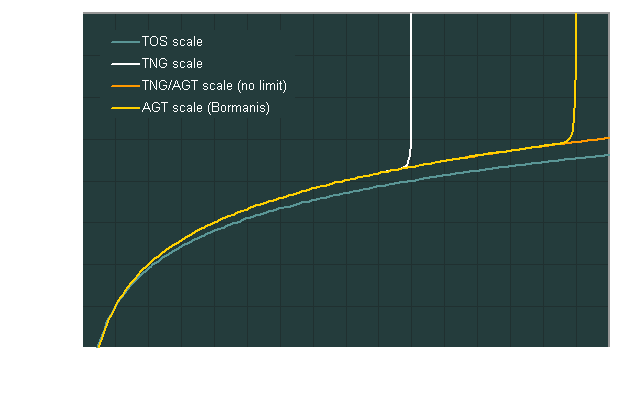
Fig. 6.7 Possible AGT warp scales
Background
The only thing really known about the AGT scale is that it permits warp factors higher than 10 that, as fans are well aware of, were not allowed in the TNG scale. The obvious real-world reason to switch to this new scale for this one episode was to emphasize that a lot has changed from 2370 to 2395 - just like the additional nacelle on the Enterprise or the new uniforms.
The in-universe explanation may be just as Bormanis suggested. At some point it would be tiresome for the crews of always faster ships to speak out warp factors in the TNG scale with always more decimal places. "Go to Warp 9.9996." and "Go to Warp 9.99996." are unhandy, and they look and sound so much alike to a human crew member that it is likely to become a source of confusion. If, however, the scale was only changed to decompress the warp factor range of high warp speeds for the sake of convenience, the question arises why it was compressed in the first place and if the move of the limit to to Warp 15 or something wouldn't just postpone the problem yet again.
Perhaps, rather than being a totally arbitrary recalibration along the lines of "We think Warp 10 is too low a limit, let's move it up to Warp 15", the new AGT scale reflects a change in the propulsion principle yet again. As already explained for the TNG scale in Section 6.3, the highest possible warp factor may denote the deepest possible subspace layer boundary that the ship's warp field penetrates. If, in the year 2395, warp engines are generally modified in a way that they reach down to the the 13th layer, the AGT scale makes sense again. And if 14 subspace layers instead of previously 9 is a commonly accepted limit, the limit of the scale may be located at Warp 15 just as Bormanis suggested, only that the rationale would be different one.
Alternatively, we could imagine that the perhaps impractical warp factor limit was dropped altogether. In Fig. 6.7, the orange curve shows the TNG warp scale without the asymptotic behavior at Warp 10 (TNG scale) or at Warp 15 (AGT scale as suggested by Bormanis).
It is even possible that the warp factors up to Warp 10 are still exactly the same as in the TNG scale, denoting conventional operation of the warp drive, but that a completely new and independent AGT scale begins above Warp 10, denoting a new propulsion system such as transwarp or quantum slipstream drive. In this case, the new warp factors may as well have been named "Transwarp I, II, III, etc." Anyway, the two scales wouldn't be compatible, but we could imagine a transition from one scale to the other. The ship naturally wouldn't go up to Warp 10 with conventional warp drive, but may accelerate up to the break-even point at something like TNG Warp 9.5 and then activate the new propulsion system. After a short transition phase in which both engines (or both working principles of the same engine) are active, the ship may end up at AGT Warp 10, which is perhaps the equivalent to TNG Warp 9.6.
See Also
Power & Propulsion - about the right intermix ratio, warp inside a star system, how to stop a starship etc.
A Close Look at 22nd Century Technology - with considerations about the speed of Enterprise NX-01
Voyager Inconsistencies - with a rant about Tom's "Warp 10" flight

Warp factor @ Memory
Alpha






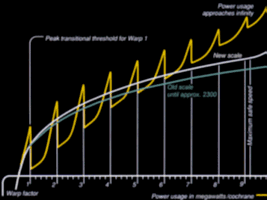
 Fig. 6.1 Peak transitional thresholds
Fig. 6.1 Peak transitional thresholds